|
[Note:
Full Disclosure:
We are a competitor to Diamond Nexus Labs. We produce the
Asha®
Diamond Simulant which uses high-end, hand cut cz and a proprietary carbon amorphous
diamond coating in its manufacture.]
For
the past few years, we've seen some very interesting marketing
techniques utilized by Diamond Nexus Labs in marketing their lab
grown gemstone. As a result of their changing claims and
advertising about what their product is or is not, many people
have been confused as to what the Diamond Nexus Labs gemstone
is. Is it really flawless man-made diamond as their ads
state? Is it a breakthrough polycrystalline compound as
their website states? Is it 'not CZ' as their customer
service verbally states?
To
try and find an answer, one might start by searching on Diamond
Nexus Labs, resulting in an ad like this:

or
this

Based
on this, a reasonable person would assume their product is real
lab grown diamonds.
Interesting,
because no lab in the world can currently produce white lab grown
diamonds and sell them profitably. Apollo diamond offers a
few small ones from their R&D, but it's not a commercial
production basis. In addition, true lab grown diamonds are
rarely 'flawless' or 'perfect'...in fact, they tend to have the
same flaws and issues their mined counterparts have (we know a bit
about real lab grown diamonds, having been the first to offer true
lab grown diamonds on the web via our http://TakaraDiamonds.com
website).
Nevertheless,
by visiting their site, we see that the terms have changed a bit -
their header now advertises:

{Screenshot, DiamondNexusLabs.com,
11/15/2007}
So
now we're unsure if they are offering diamond simulants or
lab-grown diamonds.
In
their text on their homepage, they again switch back to talking
about lab grown diamonds, stating
"We
invite you to learn more about lab-created diamonds in general
and the Diamond Nexus Labs breakthrough.."
{Homepage,
DiamondNexusLabs.com, 11/15/2007}
which
now implies their gemstones are a breakthrough
product.
To
further add to the confusion, Diamond Nexus previously used to
show product photos that were not photos of their product, but
were in fact simply altered photos of natural diamonds (google
image search was very revealing). Here is one example from
2006:
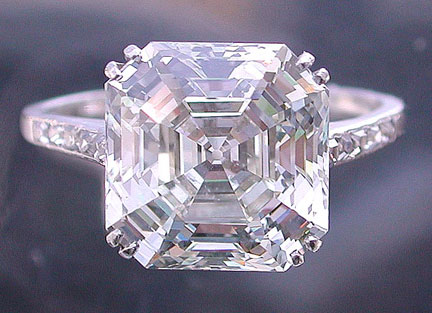 |
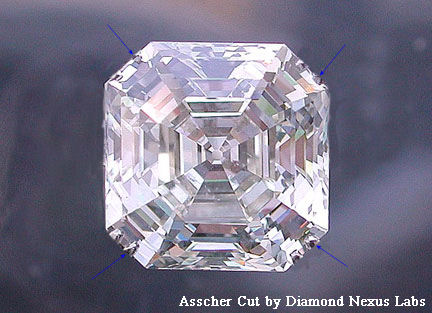 |
| Original photo
of a 1920's natural Asscher diamond by Nelson Rarities |
Photo as shown
on Diamond Nexus website and saved Sept. 1, 2006. This
photo was used as the product photo for their Asscher
cut.
(blue
arrows added after to highlight the leftover prongs). |
Seeking
more information, we
go into their 'news' center. Here we encounter more
confusion:

{Screenshot, DiamondNexusLabs,
12/06/07}
Now
we see direct claims that the product they market is "almost
perfect synthetic diamonds". This article later
mentions that their diamonds are polycrystalline, and there are
numerous other articles in the news section talking about new
"synthetic
polycrystalline diamonds"...maybe the Diamond Nexus product is
synthetic polycrystalline diamond?

{Screenshot, DiamondNexusLabs.com,
11/15/2007}
However,
gemologists do not agree that synthetic polycrystalline diamonds
are glittering or brilliant. In fact, this would be odd as
polycrystalline means "many crystals" rather than one
single crystal. These are normally used for abrasives work
and drilling, and do not make for gem quality stones as they are
normally not transparent due to having so many crystals randomly
oriented, which prevents light from readily flowing through.
The result is polycrystalline diamond of any size is dull and dark...which you can see by viewing a photo of actual
synthetic polycrystalline diamond below:
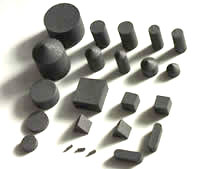
Photo of synthetic
polycrystalline diamond pieces....not very gemlike.
(Photo by Zhengzhou CutSky Industrial Co, Ltd).
Unclear
as to why all the talk about polycrystalline diamonds,
we continue reading and find this article: "Man-made
diamonds: A Buyers Guide". Here we are presented with a
comparison of various materials used to created imitation
diamonds, including some additional info on the Diamond Nexus product:
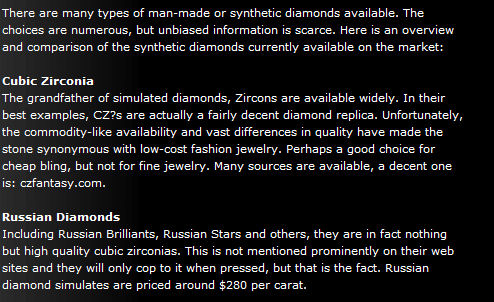
{Screenshot,
DiamondNexusLabs.com, 11/15/2007}
and
finally:
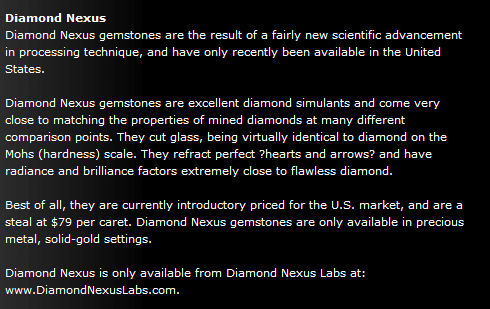
{Screenshot, DiamondNexusLabs.com,
11/15/2007}
Source
link: http://www.diamondnexuslabs.com/jewelry/newsdesk_info.php?newsPath=1&newsdesk_id=3
With
that, we are told that:
-
Many
simulant
makers are selling CZ, but don't admit to it unless pressed
(Diamond Nexus is happy to name them though),
-
CZ
is usually not good enough for fine jewelry.
-
Diamond
Nexus gemstones are the result of a fairly a new scientific
advancement, only recently available in the US,
-
Diamond
Nexus gemstones are 'virtually
identical to diamond' in hardness.
-
Perhaps
most importantly, unbiased information is scarce but that
Diamond Nexus gemstones are a steal at $79 per carat
So,
its apparently not CZ, but also not a lab-grown diamond.
This same news section has a number of articles talking about
'synthetic polycrystalline diamond', but that doesn't make much
sense since we now know that polycrystalline diamond has little in
the way of desirable optical properties.
Confused,
we go to their FAQ to learn more. We find some answers here:

{Screenshot, DiamondNexusLabs.com,
11/15/2007}
From
this we can see that it contains ingredients that are also used in
making Cubic Zirconium (Zr, Y, O), but its apparently
'polycrystalline' and contains Carbon. We also learn that
the terms to describe "diamond stimulants" are generally
obsolete. Further reading shows:

{Screenshot, DiamondNexusLabs.com,
11/15/2007}
Curiously,
while they claim multiple labs have confirmed what is in their
product, they are unwilling to cite which labs they are, or
provide any other supporting data for this claim.
With
Diamond Nexus insisting that their gemstones were a breakthrough
only recently available, advertising as if their product is a lab
grown diamond, combined with their challenge that no one had
bothered to actually test their product via a materials engineer,
we decided to spend some money and see what information an
independent evaluation would find. We wanted to be able to
make a 'bona fide statement' as per Diamond Nexus' request when
people asked what the Diamond Nexus product is.
Towards
that end, we contacted Anderson
Materials Evaluation Inc. , a leading materials evaluation
laboratory, and asked them to independently purchase a Diamond
Nexus Gemstone directly from Diamond Nexus (they simply went to
the Diamond Nexus site and ordered a stone using a personal credit
card, and had it shipped directly to their lab), and subject the
stone they received to Xray Photoelectron Spectroscopy [XPS] (a
more sensitive testing method than the XFS Diamond Nexus
mentioned) in order to settle the question of what the Diamond
Nexus Gemstone really is. You can learn more about XPS
testing here.
While
Anderson Materials has three PhD's on staff, we were fortunate to
have Dr. Anderson himself run the testing on the Diamond Nexus
Gemstone. Dr. Anderson has over 35 years of surface analysis
experience, and nearly 30 years experience with XPS.
He has served as an officer
of the ASTM Committee E-42 on Surface Analysis and an U.S. Expert
on several sub-committees of the ISO Technical Committee 201 on
Surface Chemical Analysis. He worked for Case Western Reserve
University as a post-doctoral fellow, the Dept. of the Navy as a
research physicist, and Martin Marietta and Lockheed Martin as a
senior scientist before founding AME, Inc. In short, you'd
be hard pressed to find a better person to help you characterize
an unknown material.
The
results?
Independent
laboratory testing found the Diamond Nexus Lab product to be.... ordinary
cubic zirconia.
The
same material Diamond Nexus claimed was not worthy of fine jewelry
and chided other sellers for not being upfront about. Far
from a scientific advancement or breakthrough only recently
available in the US as claimed, and not man-made diamond as
advertised, not polycrystalline compound, etc.
Here
are some excerpts from the report:
-
"The
principal elements of the gemstone are zirconium, yttrium, and
oxygen, so the gemstone is a common cubic zirconia."
-
"No Hf, Fe,
Ni, or Co were detected, despite Diamond Nexus Labs listing
them as present in the FAQ's page of their website."
-
"Immediately
after sputtering the surface with argon ions, the carbon
concentration was almost zero...During the measurement we
observed the carbon concentrations on the surface to
increase. This increase was due to the adsorption of
hydrocarbons in the XPS system, despite its great vacuum, onto
the surface. Cubic zirconia is very inclined to bond to carbon
and hydrocarbons."
-
"The claim
that the gemstone is polycrystalline must come from a
misunderstanding on their part. A cubic zirconia
gemstone which was polycrystalline would be very
undesirable...The polycrystalline material is good for furnace
bricks, but not for gemstones, especially given their claim to
make the World's Finest Diamond Simulant Gemstones."
You
may review the full report at your leisure here
(PDF format). Please note that this report remains the
property of BetterThanDiamond.com.
We
hope this information is useful to those currently interested in
diamond simulants and who don't want to be confused as to what
they are actually purchasing.
Feel
free to discuss on our message boards here.
End
report...plug for our Asha®
diamond simulant begins below to help recoup the thousands spent
on the above report and legal review for publishing
it. |